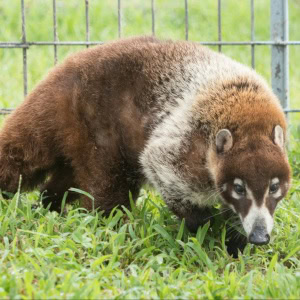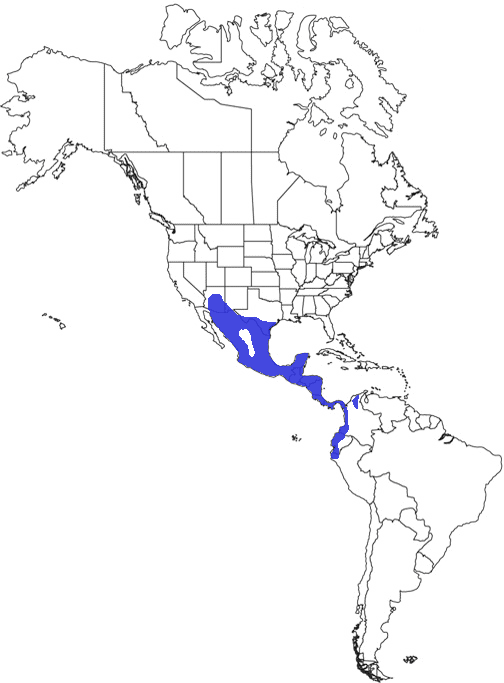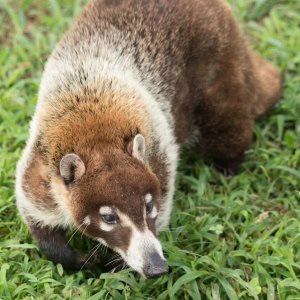
Taxonomy
Kingdom: Animalia
Phylum: Chordata
Class: Mammalia
Order: Carnivora
Family: Procyonidae
Genus: Nasua
Species: narica
Scientific Name: Nasua narica
IUCN Red List of Threatened Species Status: Least Concern
Population Trend: Decreasing
About
Habitat: White-nosed coatis are adaptable and have the potential to be found in small mountain ranges, chaparral conifers, or oak woodlands. But, they are most commonly found in tropical woodlands and open forests.

Territoriality: Coatis are social animals with females living in groups, called bands, of up to 30 other females and young coatis of both genders. Females are incredibly vocal with each other and spend much of their time grooming one another. They do not live cooperatively or share food; however, the group helps to protect the females from male intruders and threats. When the juvenile males reach maturity, they will leave their mother’s band and remain solitary, only joining a band when it is breeding season. Territories will reflect food and water availability, but the home ranges of a band may overlap with that of other bands and solitary males. Similarly, the territories of a solitary male can overlap with different male home ranges. Coatis will use scent glands located on their necks and abdomen to mark their territories.
Lifespan
In the Wild: 5 to 7 years
In Captivity: 14 – 20 years
Population
Population: The number of the species is unknown, with population estimates ranging from rare to common. Rare in the United States, common-scarce in Central America, and reduced populations in Mexico.
Physical Description
Weight: 6 to 13 pounds
Length: Average 3.5 feet, including tail
White-nosed coatis are small Procyonidae, or members of the raccoon family, and males are typically bigger than females. Their coat colors can vary from reddish-brown to black with lighter underbellies. They have black and grey markings on their face, white spots above and below their eyes, and a long, semi-prehensile tail wrapped in black rings.
Fun Facts
- Coatis are known pollinators of the balsa tree! They will stick their noses inside the flowers to drink the nectar, which also covers their faces with pollen. This pollen will then get spread around the environment as the coati travels!
- Their favorite fruit is the prickly pear!
Reproduction
Gestation Period: 70 – 80 days
Litter Size: 2 – 7 pups (Average 4)
Breeding season for white-nosed coatimundis is typically from January to April, or when food sources are most abundant. During this time, one adult male will be allowed to join a band, which he defends from other males. When a female is ready to give birth, she will leave the band to find a safe place, usually a crevice in a tree or, and not return until her young are between five and six weeks old. Young coatis, first leaving the nest, have a high mortality rate due to susceptibility to disease and accidents. They are also preyed upon by male coatis, wild cats, monkeys, snakes. At four months, they are weaned but will remain with the mother until she leaves to have another litter of pups. When the pups reach maturity, at around 15 months to two years old, the males will become solitary, and the females may either remain with their mother’s band or leave to join a different band.

Diet and Hunting Behaviors
They are opportunistic omnivores that have been known to eat fruits, vegetables, seeds, insects, reptiles, and even small rodents. They are excellent climbers and an arboreal species, using their long, sharp claws to search for food in the trees as well as on the ground. As a diurnal species, coatis are most active during the day.
Threats and Conservation
White-nosed coatimundis can be found in many countries and states from New Mexico and Arizona in the United States to Ecuador and Columbia in South America. Across their range, the threats and conservation efforts that concern them can vary greatly from habitat loss to overhunting.
As a mesopredator, coatis have an essential role in maintaining prey populations, like insects and rodents. They are also vital in the stabilization of apex predator populations, like mountain lions and jaguars. Most populations of white-nosed coatis are populous enough to be hunted by humans as a dependable food source. But, overhunting in small, isolated populations can be devastating and cause extirpation.
The exotic pet trade is also detrimental to coati populations, as they are captured as pups. This can have adverse effects on the young coatis, as well as the social structures of the groups. When they are kept as pets, it usually does not take people long to realize that they are still dangerous, wild animals, and do not belong in homes; this realization can result in the animals being disposed of.
As a whole, white-nosed coatis are classified as Least Concern by the IUCN Redlist. However, the populations in the United States are suspected of having lost genetic diversity due to habitat fragmentation and the loss of connection with southern populations of coatis. In New Mexico, because of the low population numbers, they are classified as an endangered species with total legal protection of the species in that state. However, an abundance of coatis within the United States resides in Arizona, where there is a year-round legal hunt for them.
In Honduras, they are listed under Appendix III of CITES, meaning that a permit issued by that country must accompany any white-nosed coatimundi exported from Honduras. This, in turn, will help to mitigate some of the traffickings of the species there. However, in other areas of their range, they are not offered any legal protection.
White-nosed coatis are also susceptible to some zoonotic diseases like canine distemper and rabies. They are also sometimes the victim of predator control programs, such as coyote poisoning.